What you don't know about Mineral Wool will make you look stupid.
If you are interested in green building, or call yourself a green building expert, then you should know about Mineral Wool insulation. If you have not seen Mineral Wool handled and installed, then you need to read this. If you think that Mineral Wool batts are similar enough to Fiberglass batts that you already know what you need to know about it, then you are a fool. And you still need to read this.
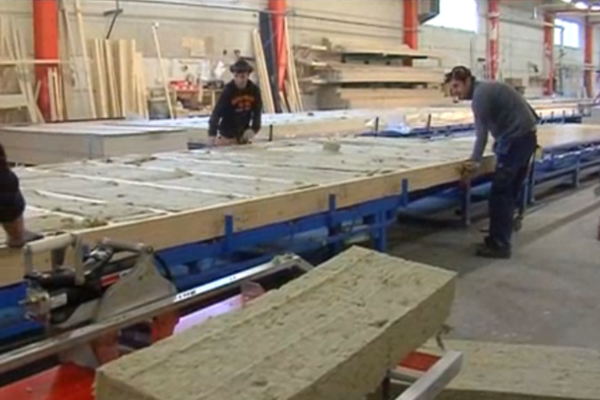
image Randek AB
If you are a regular reader here you know I am an advocate of using Mineral Wool insulation to improve the energy performance of the way we build houses in the US. There are many reasons why I think Mineral Wool is the best insulation for us here. Recently I find myself making my case for this repeatedly, so, I thought it would be worthwhile to get it all down in one place and just point to it in the future.
So why am I constantly explaining why I like Mineral Wool, and what's good about Mineral Wool, and no, that's not what Mineral Wool is like - rather it is like this… It is because the green building community has almost universally decided that ole' fiberglass batt insulation is BAD. There are good reasons for this, and we'll look at those, but the more obvious question is what does this have to do with Mineral Wool? The overwhelming assumption among those interested in Green Building is that Mineral Wool is just like fiberglass batts, at least in all the ways they feel fiberglass batts are bad. So if fiberglass insulation is bad, then they are convinced that Mineral Wool insulation will be bad for all the same reasons. Its an easy conclusion to reach, but a lazy misunderstanding. The reality is that this is just not so. In fact this simply highlights the profound misunderstanding of what Mineral Wool insulation is like among green building advocates. The misunderstanding centers around the form of insulation - Batts. The green building community has been very quick to condemn "batts", when the problems that concern them actually revolve around fiberglass batts.
Lets make this absolutely clear: There is Nothing wrong with insulation in the form of batts. Batts are a convenient way to package insulation for transport, handling, and installation, which is why it is the predominant form for insulation in the US. However there are legitimate reasons to criticize the fiberglass batt insulation which is the status quo in US house construction. Its a brief list of reasons, so lets look at them.
First, low insulation values. Thats right, fiberglass batts sold here in the US don't provide as much insulation as they could. Its not that you can't make fiberglass in higher performance levels, in fact it is made and sold in Canada at higher R values. But the big fiberglass insulation makers are not ready to bring that high R value fiberglass insulation here to the US. How do I know? I've called them, spoken to their people about it, they've told me they won't bring the high R value insulation to the states even though I said I wanted to spec it. I say shame on them, we should all take our business elsewhere.
Second, Bad Installations. Bad installations mean sloppy fitting of batts into stud cavities, either over compressing the insulation or leaving gaps that allow convection, sloppy trimming around obstructions, and any number of installation sins that spoil the effectiveness of the insulation. The installers are only partly to blame. The material is limp, and fluffy, and because of this the handling, cutting, and placement requires more care to install well. It rarely gets that care, hence it is most often installed quickly and cheaply.
Third, bad air sealing, bad vapor retarder. Well what is that about anyway? Insulation is for insulating, not for air sealing? Well somewhere along the way somebody had the bright idea to combine a vapor retarder with a fiberglass insulation batt. It turns two construction steps into one, and in theory saves labor and so saves money. The problem is that once you've had a bad installation as noted above, and cut the vapor retarder around electrical boxes, what you end up with does not seal well nor retard vapor well. Hell, you say - I don't need my insulation to make an air seal because I used that good ole' house wrap on the outside. Nope, nothing wrong with house wrap, but no help with the air sealing you need at your vapor barrier. The air seal in this case wants to be on the warm side of the wall, to prevent interior moisture from entering the wall cavity and condensing during the winter heating season.
Lets summarize the lesson here. What most green pundits blame on batt insulation is the fault of fiberglass insulation. While Mineral Wool is also a batt, it is a completely different product with many different properties. It does not suffer from any of the above problems of fiberglass, yet retains the best part - its easy to handle, easy to install, and best of all your labor force already knows how to do it. That is no small point.
Ok, lets talk about Mineral Wool. I'm going to refer generally to "Mineral Wool", but as of this writing I have in mind the product range of one manufacturer - Roxul. This is the only Mineral Wool manufacturer taking the residential market seriously in the US right now. Roxul sells their Mineral Wool in consumer friendly packages just as you would expect in a big box home improvement outlet. They are making their batts in sizes made to fit stud walls, clearly aimed at the market for building houses of wood, the very same market that fiberglass is sold to. This is important. Same kind of packaging, same kind of expectations, same kind of product experience - they are putting their product into long standing material streams that every builder in the US understands. Its available from the same sources, ready to be installed by the same people. There are other Mineral Wool manufacturers out there. They are not proactively pursuing the residential market. I'm not talking about them or their product. If your criticism of Mineral Wool revolves around your experience with some other product from some other time, then your concerns don't apply here and now. You should catch up.

image Roxul Inc
So lets talk about insulation value first. In batts offered for 2x4 stud walls Mineral Wool comes in R15, fiberglass comes in R11 or R13 (although it can be special ordered in R15 in the US). In batts offered for 2x6 walls Mineral Wool comes in R23, fiberglass comes in R19 (and again you can special order higher R value, but only R21). Furthermore Mineral Wool is available in batts that fit 2x8 framed walls, and these are R30. Fiberglass is not offered in batts for 2x8 stud walls. These are the products available now, today in Mineral Wool. If you are interested in maximizing the energy performance of your walls, its a no-brainer. Even if you changed nothing else about the way you build, you can improve the performance of your walls by switching to Mineral Wool.
Second, installations. You might think, how can Mineral Wool batts be easier to install than fiberglass batts? Its simple. Fiberglass batts are limp, soft, blankets. They have to be hung and stapled into place or they will slump and leave gaps. Mineral wool is dense, and firm, and friction fits into the stud space. People don't generally understand this, and this is why I am including photos. Mineral wool has form, it has a shape. If you pick it up it does not drape or fold - it retains its shape. It is a block. This block when shoved into a wall cavity - and I say shoved because it literally must be pushed into place - when shoved into place it fills the entire wall cavity. No gaps, no sags, no spaces. More importantly no convection, no drafts, and no stapling.
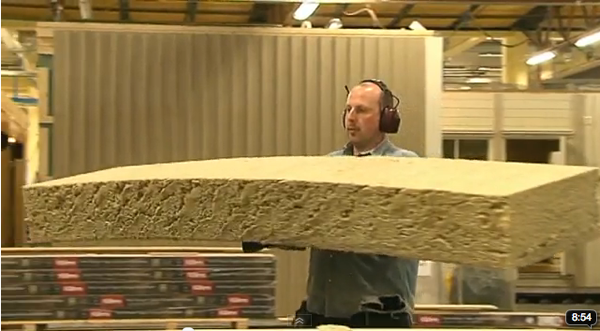
This fellow is carrying a piece of mineral wool. Note it has a shape, and keeps its shape. This is nothing like fiberglass batts. Image via Smålandsvillan.
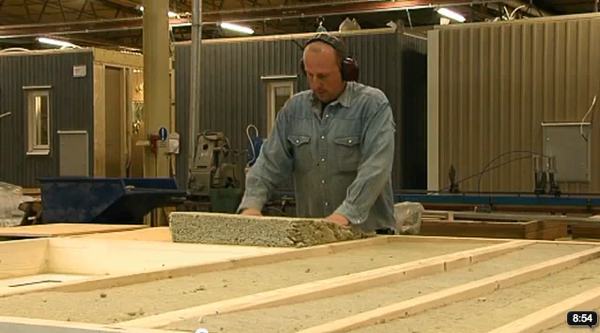
Image via Smålandsvillan.
There is one caveat here. Just as with fiberglass, Mineral Wool must be cut to fit odd spaced studs and triangular corners that may result in framing. However this is much easier to do with Mineral Wool. With Fiberglass you are actually told, by experts, to use a 2x4 stud as a straight edge while you cut the fiberglass batts with a sheet rock knife. You are expected to compress the fiberglass enough to cut through it with the short blade of the razor blade. And if you are doing it correctly, you trim the batt and kraft paper to a different width to leave a tab so you can staple it up. Good luck.
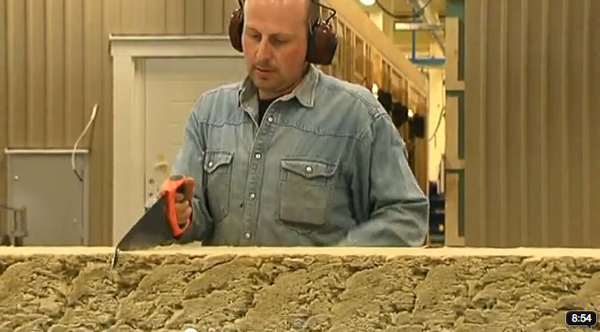
Mineral Wool is easily and accurately cut with a large serrated knife. Image above via Smålandsvillan. Image below via RepCon NW.

Mineral Wool is different. You can actually measure, and cut Mineral Wool to size, like cutting a big block of wood. In fact for carpenters this comes as second nature, because as you might expect they are quite good at measuring, and then cutting something to fit, when that something has a shape and can be understood like a piece of wood. The cuts are made with large serrated knives - imagine a giant bread knife. So no compressing the insulation flat so you can cut through it. The Mineral Wool retains its volume while you cut through it with the long knife. You don't cut against a 2x4, but rather you cut it on a purpose made cutting table which is just like a very large carpenters miter box. It adjusts for the thickness of the insulation, and allows you to set precise angles for cutting to fit those odd spaces.
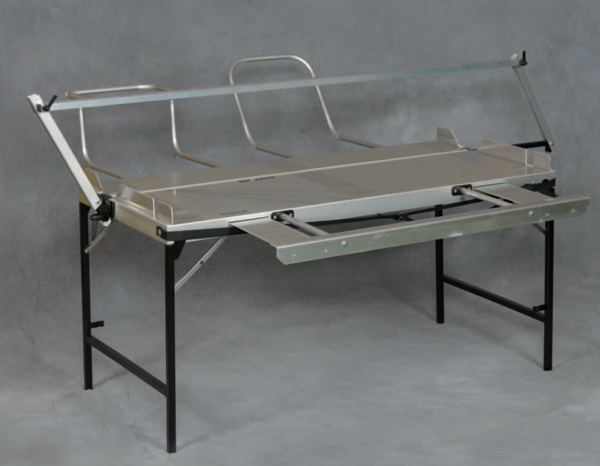
This simple table makes cutting insulation to fit into easy work. If you are a builder interested in an insulation cutting table like this, they are now available in North America. ByggHouse LLC is assisting Ego-industri AB to bring this Swedish insulation cutting table to North America. The new version marked in inches is available now directly from ByggHouse.
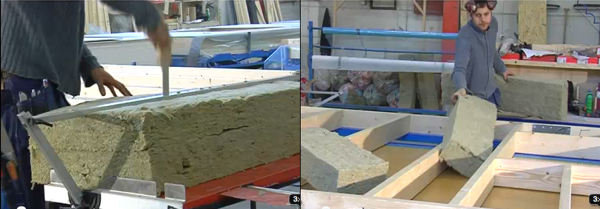 Images via Randek AB.
Images via Randek AB.
The Mineral Wool cutting table for me is the eye-opener, the cold water in the face that makes you realize that we never took insulation very seriously here in the US. Here we pull a 2x4 out of the dumpster, and use a razor blade holder to cut it on the floor deck. That's the best we can do. Mineral wool is cut precisely to fill every void, quickly, accurately, providing complete fill of the wall cavity. Installs are easier, faster, better than fiberglass. I'll say with some confidence that no other insulation product can fill a stud space so completely. No spray, no blown, no blanket can fill a wall void as well as a proper Mineral Wool installation.
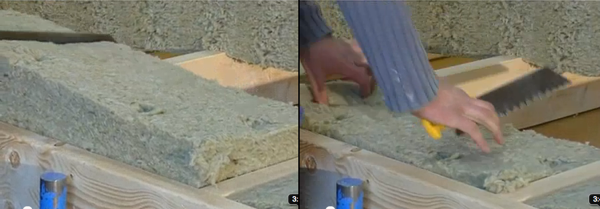
Images via Randek AB.
And third, air sealing. Mineral Wool only comes in un-faced batts. No foil or kraft paper vapor retarders are offered. This means an independent vapor retarder must be installed. Simply said, this is the best way to create an air tight envelope for the house. My favorite product in this regard is a variable permeability membrane, a so called "smart membrane" because the permeability self adjusts to suit conditions. An example is the "MemBrain" vapor retarder from Certainteed. This is their branding of the smart membrane product made by their European owner, Saint-Gobain. Another high quality variable permeability membrane is Intello Plus and DB+ by ProClima. This vapor retarder membrane has a low permeability level in dry conditions, but if the humidity level within the wall gets high, the material will open up to allow the moisture to dry to the other side. The ProClima Intello membrane is notable because it is well reinforced. It will not tear or split from stapling, and this tolerance of handling makes it easier to work with.
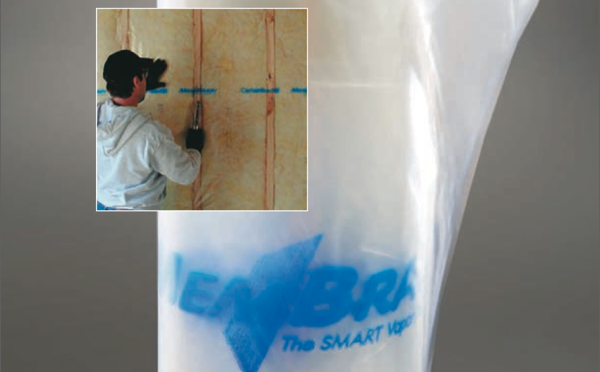 Images via Certainteed.
Images via Certainteed.
Now if you wish to increase the likely hood that you won't need to make any punctures in this air tight layer, then you should plan on a wall with an interior wiring chase, such as the USA New Wall that we've elaborated here. Your best chance for an airtight wall is if you don't puncture your air barrier with electrical work, outlet boxes and switches. If you've not studied it before, when you are done here go read the USA New Wall article, and the Swedish Platform Framing article to see how all these come together to make a simple but high performance wall.
That covers insulation value, installation, and air sealing issues. Mineral Wool goes on to excel in other ways that contribute to my preference for this material.
Mineral Wool is hydrophobic. From the dictionary: tending to repel or fail to mix with water. If fiberglass insulation becomes wet, you end up with a wet lump of glass lint, with no insulation value to boot. Mineral Wool on the other hand will not become wet. Water in fact beads up and rolls off the surface of Mineral Wool. This promotes water draining and drying if the wall cavity becomes wet, rather than holding water like a sponge. Which would you rather have in your wall?
One of the big issues with improving performance of our walls is the thermal bridging of the wall studs. The most popular way to overcome this has been to install insulation on the exterior of the wall, continuously, to insulate the studs from the cold. The issue here is that rigid foam insulation has been the most common way to do this. The problem however is that the foam creates a vapor retarder, and the last thing you want is a wall with a vapor retarder on both faces. So the practice has been to make walls with exterior foam insulation without interior vapor barriers. The foam must be thick enough to keep the dew point of interior water vapor within the depth of the foam in order to prevent condensation within the wall cavity. The problem here is that only the most general recommendations for these configurations can be made in the building code. Weather outside the design limits can result in condensation. Highly humid interior conditions can cause condensation. My opinion is that these walls are not resilient designs, and are poor practice. A wall with a traditional configuration with a vapor retarder to the interior works in all conditions, even when the temperature or interior humidity goes beyond the design values. My only caution is if the home is to have air-conditioning then it is very important to use the smart vapor control sheets mentioned above. These variable permeability membranes will ensure the wall performs well during the cooling season when the vapor profile of the wall is reversed. The good news in this story is that Mineral Wool comes in configurations that can be used as exterior insulation in place of foam. These are very dense fiber panels that are strong enough to support siding and cladding material mounted over them in a manner similar to foam. The difference - Mineral Wool is vapor permeable which means you can insulate on the exterior without trapping moisture in the wall. Furthermore the insulation value of these dense Mineral Wool panels approaches the performance of foam. Typically for XPS foam you would get in the neighborhood of R5 per inch. The Mineral Wool will provide R4.6 per inch. And because of Mineral Wool's hydrophobic properties it will not absorb moisture in this location, and in fact will promote the drainage and drying of rainscreen siding cavities. Foam insulation brings other problems, such as a dilemma in flashing practices, and the dubious reliance on adhesive tape as a long term weather barrier.
Last is Mineral Wool simply makes wood stud construction safer. This is the same material that is used to fireproof steel members in commercial construction. Mineral wool will stand up to temperatures that will reduce fiberglass to a puddle of molten glass. Mineral Wool will increase the length of time that a wood framed house will stand during a fire. It gives the occupants more time to exit safely, and firefighters a safer window of time to enter a burning home.
Lets just go over some broad conclusions now. Mineral Wool is a completely different material than fiberglass, they both just happen to fall in the broad classification of batts. Mineral Wool is available in much higher insulation values than fiberglass. Mineral Wool's rigid shape and ability to be measured and cut accurately enables it to fill stud voids more completely than any other insulation product, with less effort, and more speed. Mineral Wool fits into the building practices of 99.9% of Americas' builders with no need for new process, extensive re-training, or changes to new sub-contractors, new suppliers, and new business relationships. Mineral Wool is the easiest way for the vast majority of builders to step up their game and start building better.
--
Appendix 1: Concerns of Green Builders (Edit - nice thing about rants they tell me, you are free to go back and edit them. I wanted to replace the original discussion of cellulose which has been a distraction with information about formaldehyde and embodied energy which are concerns of green builders.)
Those focused on green building often immediately point to the presence of formaldehyde in binders in mineral wool. Formaldehyde based resins have long been used in the "glues" that prevent fibrous insulation from coming apart. Its long been used in fiberglass and is still in many fiberglass products today. But it is clearly on the way out. Fiberglass batts from Knauf and Owens Corning are now available with alternate binders. Mineral wool still contains a very small amount. The wall insulation products from Roxul meet the GreenGuard Children and School certification standard which means they are consistent with products that are used in schools, daycares or other environments where children spend significant periods of time. What this means is if you are a builder shifting from traditional fiberglass batts, this mineral wool will likely have less formaldehyde emissions than what you used before. If you are a green builder seeking to eliminate any formaldehyde, then you have other options.
On the matter of embodied energy, the Roxul products now use from 75% - 93% recycled content depending on the availability of the raw materials, and their facilities are zero waste to land fill. If you are a green builder that can get the same performance from a material with less embodied energy, then great. If you are a builder considering shifting from fiberglass, the energy savings from the lifetime performance of the mineral wool will greatly exceed any difference in manufacturing energy of the fiberglass you use now.
--
Appendix 2: Predictions. Higher R value insulation will eventually own the market here. Right now Mineral Wool is the only offering in these higher R values. Certainteed, one of the biggest US makers of Fiberglass is now owned by Saint-Gobain who is a large producer of Mineral Wool in the EU. They now have access to Mineral Wool, and could begin to sell it in North America as it gains market share. Owens Corning, the other large American insulation maker who is also highly vested in Fiberglass has purchased American mineral wool manufacturer Thermafiber, widening their market to include both mineral wool and fiberglass. The third large American manufacturer of fiberglass insulation is Johns Manville, who has recently acquired American mineral wool manufacturer IIG (Industrial Insulation Group). Not all of these companies are actively promoting mineral wool for residential building insulation, but it is remarkable that we find all the major American insulation manufacturers vested in mineral wool.
Fiberglass has also been dogged by health questions. In 1984 fiberglass was classified as a "reasonably anticipated" carcinogen". This did not proceed to "known carcinogen", and in 2011 following more research it was removed from this list. Currently fiberglass is classified similarly to Mineral Wool which is considered to be what is called "biosoluble". This means that these mineral fibers dissolve in contact with tissues, leaving no fibers to trigger disease. Whether fiberglass can shed its unhealthy reputation, or if it will be overtaken by mineral wool with its higher performance levels has yet to be seen.
--
Learn more about building high performance walls with mineral wool here:
- USA New Wall: Walls for the US market based on Swedish wall assemblies.
- Swedish Platform Framing: Energy efficient update to platform framing.
And we have a series of short intro videos on these subjects:
- Why we look to Sweden for improving building in the US.
- USA New Wall - a nordic layered wall system
- Swedish Platform Framing - comparison to standard framing
--
If you are a builder or developer and you would like to receive updates from us targeted about USA New Wall - our mineral wool based wall systems, or Swedish Platform Framing - a high performance version of platform framing, customers building these walls, and our House Plan products using these wall assemblies, then sign up for our Builder Newsletter:
We have a strong program for collaborating with Builders and Developers working with these wall systems and building from our House Plan products. Read about it here.
--




OK Greg. You've convinced me. We're going to use Mineral Wool on our next two homes and see how it goes.
ReplyDeleteI wonder if in your research you have found out how durable it is during the building process if it gets wet. In other words, if you were assembling prefab wall components with the insulation in the walls and it gets rained on prior to the house being completely dried in, do you think it would be a problem?
Based on your description of it shedding water and not absorbing it, I would think this is possible...
I think it would shed the water, and any water that did find its way into the fibers would dry out afterwards. If you watch that video above, once they get through that fire test you'll see the clip where they push that cube of mineral wool into the water. You can see how it beads up.
ReplyDeleteFor the exterior insulation initially I was looking at their RockBoard product which is under their Building Envelope section of their web site. It comes in different densities, and for putting siding over it I'd use the RockBoard80 which is the most dense.
Since then however they've come out with a material under their Residential product line which they are calling ComfortBoard IS (for insulated sheathing). I'm guessing that this is simply a re-branding of the RockBoard material.
Mineral wool batts have been competing with fiberglass batts for awhile in our neck of the woods (Vancouver / Lower Mainland, BC). I'm in agreement with you that mineral wool has some excellent possibilities although I have concerns that Roxul still, as far as I know, includes up to 6% formaldehyde as a binding agent, at least in North America. In Europe, I believe they've changed the binding agents so they're technically formaldehyde-free. Formaldehyde is also now listed as a 'known carcinogen' so I'd really like to see Roxul rework things here too.
ReplyDeleteBy the way, I really enjoy your blog, you've got a lot of forward thinking ideas and thanks for sharing.
Shawn!
When I asked Roxul about the binder I was told that the off-gassing was complete before the product left manufacturing. That said, its still in there, and my understanding is the same as yours, that they use a different formula binder in EU - likely an acrylic as has been adopted by the fiberglass manufacturers.
ReplyDeleteI expect this to come here as well, along with the bio-soluble formula for the fibers. Exactly when, I don't know, but the fiberglass manufacturers are quickly moving this way with Owens Corning the latest big player to make the switch. If Roxul wants to take a piece of this market, and I think its clear that they do, then they will have to follow suit soon enough.
But in the meantime the average builder, sadly, is not much concerned with this issue. The market will make the move to eliminate formaldehyde despite their indifference, and we'll all be better off for it. I want to enable them to build better performing houses while this all goes on.
Thanks for reading Shawn!
Thanks for the great post! I will be sending lots of builders and clients here for this info... been pushing the Roxul insulation for awhile now, but getting some resistance due to unfamiliarity. I am especially interested in the RockBoard for exterior use to warm up the siding/minimize bridging, which seems like a no-brainer over foam considering it is non-flammable and might even improve fire resistance (thinking of wildfire rather than house-started fires).
ReplyDeleteNot sure I'm convinced yet of the drawbacks for cellulose, though... can you point to some references to back up the claim that moisture will negate the effectiveness of fire retardant? First I've heard of it is here. I still like the idea of a 2x4 or 2x6 wall with cellulose & ideally an interior-side service chase, then rigid Roxul on the exterior. With vapor control on the inside. Until now, my assumptions about cellulose have been that:
1. Cellulose can act as a reservoir to accommodate moisture swings if needed.
2. If dense-packed, then fire is not a huge concern since there is no room for air movement (i.e. you need oxygen for a fire).
All that said, I like what you are saying about minimizing the # of subs/specialties and just using MW throughout.
Also, we ARE seeing some blown-in fiberglass in walls here in the northwest. I'm not specifying any, but it is out there.
Cheers,
JB
Greg - Have you done much research on pricing differences between the boards? I am thinking about using a 1-2" thick board in between the two 2x4 walls of our wall assembly. Vapor barrier location TBD ;) We don't need a dense product or exterior product for this.
ReplyDeleteI also don't think cellulose is quite as bad as you state, but I will say it is more expensive and difficult to install and finish (drywall) than it appears Mineral Wool will be. I wonder what a comparison with the cellulose batts would be like that are on the market (not readily available or being pushed by manufacturer).
There are some annoying subcontractor issues with cellulose popping up as well in regards to mechanical subs voiding a section of a wall and covering it up so we can't even tell at the end of the day. Just found a void in one of our homes that has been built and lived in for over 6 months when it got really cold that we had no idea was even there... That would not happen with
Jack, interesting feedback - thanks for that.
ReplyDeleteRe. cellulose, I've also read about this characteristic to absorb, hold, and delay vapor transfer - its almost desiccant like. It will hold moisture this way, and release it later when the vapor pressure shifts. That is a beneficial characteristic. As far as the question of water and the fire retardent - I've not read that anywhere in particular, its been related to me by people using the material. Simply, the retardant is water born and applied with water; if exposed to water again it can dissolve and be carried off. My understanding is that the retardant is a salt of some kind. As far as creating voids my understanding is that the material will consolidate when wet. So even if its dense packed, if it becomes wet it will condense and can leave voids. I realize this is not by any means about to burst into flames, but its less than ideal property for the material.
If you are using cellulose successfully, I think that's great. The vapor permeable mineral wool may be a better compatible exterior insulation for a wall where you use cellulose as well.
Chad, yes - you can get the material in all sorts of increments - 1-2" for sure. It won't be in the consumer packaging you see above, but you can look at the commercial product list and see the different configurations. I would guess that a 1-2" thick acoustical batt would be ideal for what you are talking about. Its close in density to the stud wall insulation and comes in the thinner thickness.
ReplyDeleteI'm guessing you are interested in putting this in the thermal break space between the double stud walls?
Look at Roxul AFB (acoustical fire batts) - 1", 1.5", 2" (no Rvalue given)
or
Roxul CavityRock, also in 1", 1.5", 2" R4.2/inch.
Both under Building Envelope, Products on roxul.com
is there anywhere to find an easy cost comparison between the products? some sort of chart or pricing list?
ReplyDeleteWell Lowes has the mineral wool on its web site, so you can compare it to other insulation they sell. Not sure if you can make such a ready comparison to blown or sprays this way.
ReplyDeleteMy girlfriend and then consequentially myself recently developed an addiction to the HGTV show "Income Property." It is pretty standard HGTV fare but it is produced in Canada and therefore uses Roxul in just about every episode. Some episodes show more of the installation than others but it really demonstrates the friendliness of the material, showing installation by regular laborers and occasionally homeowners(even kids). The show mainly focuses on converting basements to rentals and they really emphasis the soundproofing and fire rating qualities of the material. It is a nice mainstream demonstration of a product that until now I had only had the opportunity to read about.
ReplyDeleteAh, thanks for that info. That's a great way to see the material being handled.
ReplyDeleteLowes has it for $40.77 for a 12-Pack 47"L x 15-1/4"W x 3-1/2"D (R-15), or $0.87 per foot.
ReplyDeleteFiberglass insulation for the same width and depth (R-13), but length of 384", is $10.40, or $0.33 per foot.
So the mineral wool is almost three times the price per foot (2.8X).
I agree, it has some nice properties, but is it worth the money?
First off, I'm not sure that Lowes has the best prices on the Roxul insulation. Second, the pricing at Lowes will vary by location. For instance the Roxul bay you quote at 40.77 comes in under 40 on the Lowes web site for my location. The fiberglass you quote comes in at 17.97 which translates to .56 per foot. Not nearly as large a difference as you quote.
ReplyDeleteLowes goes on to offer the same brand of fiberglass in R15, 7 pieces of 93" material for $35.81, which works about to about .64 per foot. Not that much less than the Roxul.
So is it worth it. Maybe not in all places, less likely where climate is mild. You are in California? There is a wide variety of climates there, but unless you are in the mountains, winters are mild. But anyplace where you have a substantial winter, yes it will be worth it, and certainly the easiest way to build a high performance wall. And no doubt if that is your goal you likely won't be looking at R13 batts.
Agreed that Lowe's maybe is not the best source... but just for fun:
ReplyDeleteMy Lowe's (Portland, OR) has 5.5" thick Roxul for $0.89/sf vs. Johns Manville (fiberglass) for $0.47/sf. I'm looking at the 23" wide batts, on the assumption that we're doing advanced framing.
Important to note that Roxul is R-23 while the fiberglass is R-21.
Plus there is the installation cost to consider: A good insulation job (without gaps) should go much faster with Roxul than with any fiberglass batt product (that is, if you believe you can even get a good FG installation). And it will only take one job for an installer to realize they can breathe during the process without risk of gagging on stray fibers.
Yes - its all in the density. Note that the R13 batts were almost half the cost of the R15 batts in fiberglass. It takes a lot more fiberglass to get that extra two points.
ReplyDeleteFor instance, the fiberglass manufacturers sell R24 5.5" batts in Canada. They could sell them here, but would they be less than the Roxul?
Good points, and thanks for responding to my post about batts. I like Roxul, and look forward to them offering their rigid insulation board in the US sometime down the road. The higher R value of mineral wool is good, they are certainly a step up from fiberglass batts, but they can still suffer from poor installation as can any batt product, more so than blown in materials.
ReplyDeleteOn a related subject, I just saw a spray foam installation the other day that was truly horrible - it ranged in thickness from 0" to 4" - really, I could see the sheathing from the inside. Just goes to show you that as John Straube says, you can't idiot proof anything, the idiots are too smart.
Hey, you've definitely convinced me. I'm just an amateur, but I've tried to cut fiberglass in the past, and it's just a ridiculous task to get right.
ReplyDeleteWhich brings me to the cutting table you refer to. Did I miss something? I didn't see a link to who makes it or where you get it.
I'm grateful for your blog, by the way. I especially loved the video comparison of Swedish and American manufactured housing. Talk about an eye-opener!
I don't know of anybody selling the insulation cutting tables in the US, but we're going to try and do something about that.
ReplyDeleteGlad you are enjoying this information. Next thing is to build you a house like this! ;-)
I too want to get a cutting table! I'm planning to insulate the double stud walls of my 'dream house' in northern Michigan with Roxul bats. All my framing will be 24" OC 'advanced framing'. My outer exterior walls will be a mix of 2x4 and 2x6, the 2x6 bear the roof trusses which must support significant snow loads while the 2x4 are gable ends these walls will be erected without sheathing. My inner walls will have their exterior face sheathed with OSB that has a liquid vapor barrier applied to it before erection thus providing a service cavity which will be insulated with bats. My inter wall space will be 3 1/2" and totally filled with bats after the roof is on. Am I being a pioneer or has anyone insulated between double stud walls with Roxul bats?
ReplyDeleteJerry, hopefully you get notified of this reply to your comment. The first lot of tables marked in english units is coming to the US. If you are still interested now is the time to reserve one.
DeleteThank you s much for this article! I am a Residential Sales Rep for Roxul in the northeast US covering NY, CT, and parts of MA. Please don't hesitate to contact me even if you live elsewhere. We are all willing to answer any and all questions and appreciate the buzz and support surrounding Roxul. melanie.bisson@roxul.com
ReplyDeleteGreg,
ReplyDeleteHas there been any progress on a way to obtain the cutting table in the USA? I'm about to make a version of it out of plywood and 1" square aluminum tubing and aluminum angle stock. I'll simplify it a bit as I see no need for angle cuts. Have you tried using an electric carving knife?
Regards
Jerry Liebler
No progress to report, but not forgotten. If we manage to organize the order of a batch of these we will post about it here.
ReplyDeleteElectric carving knife would likely work since it is essentially a serrated knife. But the length of the blade is key if you are working on the thick stuff for ceilings.
Any advice on fastening methods for Roxul ComfortBoard IS 2" thick over plywood, studs 16" on center? I want to avoid inconsistent compression and wavy siding and was thinking of trying the section of plastic pipe under the strapping. Attaching oil filter wrench to drill and using that to insert 2" sections of pipe so that the screws can't compress the roxul any more than that
ReplyDeleteI understand why you want to use the spacer, and I think it would work, but I think you'll be creating a lot more work for yourself to insert them, and have a hole in the insulation for the spacer to fit into.
ReplyDeleteThere are screws made specifically for this application, which has a blind spot in the middle of the threads that allow it to spin until the tip takes up in the sheathing. Look for the Heco Topix Therm. Here is a video that was poted by a fellow Albert Brooks that has been working with these:
http://www.youtube.com/watch?v=EQBai5vbvDg&feature=youtu.be
I've also seen some fittings offered for commercial construction that were a plastic "washer" if you like, with a long "pedestal" that would extend through the foam to the sheathing, and prevent the screw from compressing the insulation when it was set. The flat plate gave you a surface to screw battens into. I'll see if I can find a link. This is a Swedish company, and I don't think these are available here:
http://www.combimix.se/fokus/fasad/103
Could someone advise me as to whether Roxul can be pieced together? Example: I need to fill 16" gap but some of my batts are 24" wide; I got a great deal from someone selling unused leftover material. Could I piece the cut off 8" remnants together successfully? As this is an expensive product, I hate to waste any. Thanks for any advice.
ReplyDeletePeggy, Roxul Stone Wool is meant to friction fit into the stud spaces. So its hard to say if two 8" wide cut-offs from the 24" spacing batt will fit well into the 16" space. You are going to have to try it.
DeleteThank you for your reply.
ReplyDeleteYes, I am concerned about the friction fit aspect before perfectly cutting perfectly good 28" wide batts. No friction, no fit. Ugh.
Second question that came to me after I posted: My ceiling joists are almost 7" deep(5" thick!). It is a very old house. I would end up with a huge air gap with 3" Roxul which is what is available locally. I could use two layers of 3" but there would still be an inch of dead air. This will effect deadening properties, yes?
Any thoughts?
Peggy, for sound deadening, no - the batts do not need to fill the entire thickness of the void, but should should fill the entire width and depth of the joist space.
DeleteIf this is not for sound, but rather insulation then you should fill the entire space. For a 7" joist you might want to try the R30 which is 7.25" thick.
Thanks for replying.
ReplyDeleteThis is for sound so I should be alright with some air void. Thank goodness.
So difficult working around the quirks and oddities of a very old house. The wall studs in one room are spaced randomly at 13 5/8's, 13 7/8's, or 13 1/2"; roughly 13", not quite on center. lol.
Thanks again for all the help. I am very grateful.
Great article. I see the benefits of using mineral wool to tightly fill cavities, which leads me to a wonder how to use it in my specific application.
ReplyDeleteI want to add some R-30 batts to the attic of a '50s ranch house. Currently, there is the original rock wool insulation between 2x4 ceiling joists at 24" o.c. It's fairly thin and/or compacted, not even coming to the top of the 2x4 joints. The batts are floppy, like fiberglass, except heavier. The old batts also have a kraft paper face on the interior side. I've heard different things about which side the vapor barrier should go on or if there should even be one in my area (North Texas).
I'm wondering if it would be more effective to add the R-30 batts on top or replace the old batts so that there's a tighter fit between the new batts and the joists.
Sam, if you put Roxul's R30 7.25" batts between your joists, you'll have nothing covering the tops of the 2x4s. What I would do is use two layers of R15 3.5" batts. Put one between the joists, and the second over the joists running the other direction. If you want to step it up, make the second layer of their R23 or R30.
DeleteGreat article Greg. While eliminating the formaldehyde would of course be great thing; I wonder how much of a concern this is when insulating attics? Assuming the attic is vented, and there exists reasonable air sealing between it and the living quarters, then I wonder if the presence of the current levels of formaldehyde would be cause for much concern. Just a thought. What do you think?
ReplyDeleteRoxul's explanation is this: They use such a small amount of formaldehyde in the manufacture that it is nearly all driven off by the heat of the process, hence the green guard rating of the material.
DeleteSo unless you have some particular sensitivity to formaldehyde, I would not be concerned about it at all, walls or roof.
Some are of a mindset that not only do they not want formaldehyde in their house, but they don't want products that utilize it at all, well then you have other options until Roxul eliminates, which is inevitable. I am quite sure the new plant they are building in the US will not use the formaldehyde binders. They would not build a new plant that used anything but the new binders as in the EU.
Nice article.
ReplyDeleteI'm considering using mineral wool in a restoration I'm working on right now. The house is from 1890 and has no exterior sheathing (siding is nailed directly to the studs), but the existing cedar siding is in good shape and I don't want to tear it down.
Seems to me that mineral wool is my best option since it's waterproof and I don't have an exterior vapor barrier. My plan is to install mineral wool batting between the studs then add a vapor and air barrier (wrap or paneling) on the interior side of the wall to create a sealed space. How does this sound?
This is my first restoration and I'm grateful for any guidance.
Thanks,
Adam in Virginia
Adam, you should email me as I'm not posting advice like this in comments any longer. And when asking for advice you should also read this post.
DeleteAdam,
DeleteI have the exact same situation as you do. I have a balloon-frame 1890s folk victorian home with no sheathing. I have been to a few consultants and they can't give me a straight forward, proven answer (got my money back). I even had a few tell me not to insulate the walls at all! I was wondering if you had found the answer or if you had installed Roxul and thought that did the trick.
Thanks!
Chris in Virginia
Dear Readers,
ReplyDeletePlease, no more requests for advice in the comments, they will only be removed. If you want a consult use the contact link in the right margin to reach me with your questions. I'm happy to consult if you want advice.
thanks, Greg
Just wondering, how to you get 1.5 inch thick batt for the wiring chase? Cutting a 3 inch batt vertically? Doesn't sound that easy.
ReplyDeleteNo, you would not split thicker batts. Roxul has 1.5" batts in their Building Envelope line rather than their Residential line.
DeleteI would use their acoustical fire batts - Roxul AFB:
http://www.roxul.com/products/building+envelope/roxul+afb
where can I buy it with the aluminum facing in South Florida?
ReplyDeleteI'm installing it in a Gas Dryer made for drying ink on printed shirts.
The manufacturer of the equipment used the MW w aluminum facing, Howerever due to the lack of owner maintenance, the sheets are falling apart, the aluminum fqacing is destroyed.
I refurbish used printing equipment, and need to find the product so I can replace.
i cannot sell a pc of equipment that is a fire hazzard due to missing the MW insulation.
Just FYI, the equipment manufacturer will not sell nor inform me of where to purchase.
You need to look for it on roxul.com, look under insulation for industrial uses, and you'll find foil wrapped material for the application you are describing.
DeleteEdits to the appendix are coming shortly. I am just finishing putting my notes together and will be editing information in the next few weeks. Updates will concern:
ReplyDelete- Fiberglass removed from suspected carcinogen list in 2011.
- Fiberglass insulation maker Owens Corning purchase of domestic mineral wool maker Thermafiber.
- Fiberglass insulation maker Johns Manville purchase of domestic mineral wool maker IIG.
Mineralwool is the common name for all insulationwool that comes from minerals, like stone and glass. At least in Sweden, Scandinavia and Europe where Roxull comes from. That is, mineralwool = stonewool and glasswool, just made of two "different" kind of minerals (stone or glass). And glasswool is also named fibreglass (or more common "glassfibres") in Scandinavia.
ReplyDeleteSo it seems just like you have a bad manufactured "glassfibres" in north america that you call fibreglass?
The biggest difference between the two kind of (well made scandinavian) mineralwool is that stonewool can take much higher temperature (good for fireprotection).
You can compare the two yourself from www.isover.com (makes mostly glasswool) or www.paroc.com (makes mostly stonewool), www.rockwool.se (makes mostly stonewool).
Best regards
Mr. Lundqvist
Yes, in the US we use mineral wool almost exclusively to mean stone wool. We refer to glass wool as fiberglass.
DeleteStone wool has some superior qualities such as the high temperature melting point, but the main point that concerns us today is the higher R values and better performance that stone wool offers today. Glass wool is not sold here with the same R values, which also means the glass wool is less dense, and along with that comes the handling and cutting challenges that lead to poor installations.
I work for a commercial window installer and we typically use rolls of insulation to wrap around the windows as the sheets tend to crumble and fall apart when we use them to fill the cavities around the windows. Do any mineral wool manufacturers sell their insulation in rolls?
ReplyDeleteRoxul's commercial products may be available in rolls. You'll have to check their site.
Delete